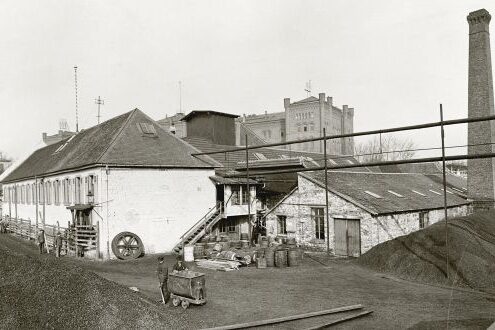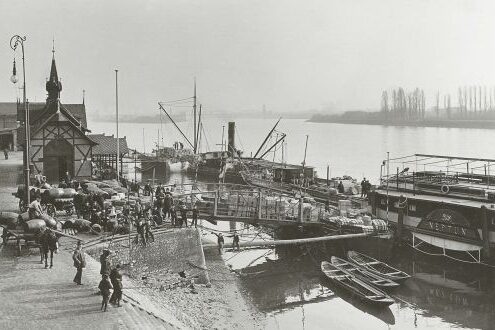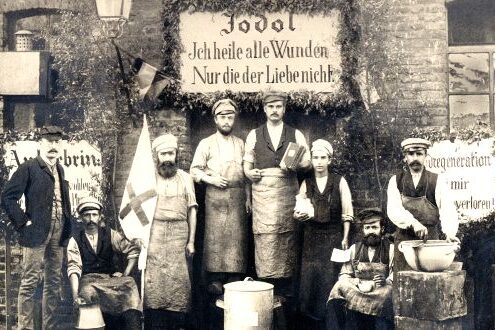Chemische Fabrik Kalle & Co.
In 1863, the chemist Wilhelm Kalle founded a paint factory on the banks of the Rhine in Biebrich, which expanded rapidly under his management and gained a worldwide reputation.
Chemische Fabrik Kalle & Co, later Kalle & Co AG, in Biebrich was founded on August 8, 1863 as a limited partnership by Dr. Paul Wilhelm Kalle . Initially, his father Jakob Alexander Kalle (1796-1865), who had made his fortune as a merchant in Paris, was a limited partner for a short time.
The company initially started with just three workers in rented premises in the former Kurfürstenmühle mill on the banks of the Rhine in Biebrich and exclusively produced paints, including "Biebricher Scharlach" from 1879. The color led to the name "red factory" among local residents.
Production of pharmaceuticals began in 1884. From 1865 to 1881, Jakob Friedrich (Fritz) Kalle, the founder's older brother, was a partner in the now general partnership; in 1897, the founder's son, Wilhelm Jakob Ferdinand Kalle, also became a partner in the general partnership. In 1904, Kalle was converted into a public limited company. In 1907, Kalle & Co. AG formed a special-purpose partnership with Farbwerke Hoechst and Cassella-Farbwerke, characterized by reciprocal capital ties and supply relationships, whereby the companies retained their independence.
Under Wilhelm Kalle's leadership for more than 50 years, the company gained a worldwide reputation. The workforce, which consisted of three workers in 1863, had grown to 50 in 1870, almost 700 in 1904 and 1,300 in 1913. Whereas in 1864 the company offered around 15 types of paint, by 1900 it had 98 patents and 160 trademarks. From the very beginning, the Kalle company attached great importance to exports. In 1882, a branch was established in New York; in 1884, a factory was built in Kolomna near Moscow, and in 1892 a plant in Warsaw. In 1913, the company had 111 branches worldwide; 80% of production was sold abroad.
The outbreak of the First World War led to severe losses for the company as a result of being cut off from the world market. Due to the Treaty of Versailles, the post-war years resulted in the delivery of paint stocks, the end of exports and the loss of all patents abroad. In 1920, Farbwerke Hoechst acquired the shares still held by the Kalle family, thereby increasing its existing majority. In 1924, there was a risk of the plant being shut down and all production being transferred to Hoechst, which was prevented.
In 1925, the Kalle company, which had well over 2,000 employees at the time, joined I.G. Farbenindustrie AG, together with the majority of the major chemical companies in Germany, after having had close contractual relationships with each other since the First World War. However, the merger to form IG Farbenindustrie resulted in a complete reorganization of production. The production of the previous products, paints and pharmaceuticals, had to be discontinued.
Kalle & Co. AG had already started producing diazo tracing paper for ozalid copying in 1923. This diazotype was based on a light-sensitive paper with great stability before exposure and high light sensitivity for sharp reproductions. In 1920, the first drying process for diazotypes was launched on the market, in which development was carried out using ammonia vapors. In 1928 the production of cellophane was started, in 1929 the production of seamless sausage casings under the Nalo brand, and in 1932 the Ozaphan film was introduced to the market, which was of great importance for the film industry and amateur photography. Plastic films were also produced from 1939/40.
In 1938, the company moved into a new administration building on the Rhine. The workforce had grown to 3,142 employees. The economic upswing was abruptly interrupted by the outbreak of the Second World War. In 1944, 40% of the factory facilities were destroyed by bombing raids. At the end of the war, production was stopped, the company was placed under Allied control and part of the plant was dismantled.
When I.G. Farben was split up in 1952, Kalle AG was re-established as an independent company. In 1972, Kalle (now with around 8,200 employees) was incorporated into Farbwerke Hoechst AG, renamed "Kalle, Niederlassung der Hoechst AG" in 1974, renamed "Hoechst AG, Werk Kalle" again in 1986 and merged with the neighboring Albert plant in Mainz-Amöneburg (previously: Chemische Werke Albert) in 1989 to form the "Werk Kalle-Albert" of Hoechst AG. Soon afterwards, the reorganization of Hoechst AG began, combined with a considerable reduction in personnel at the Kalle-Albert plant.
In 1997, the Kalle-Albert plant became the "Kalle-Albert Industrial Park", which is now home to numerous companies, including Clariant, Agfa, Mitsubishi Polyester Film, SE Tylose and today's Kalle GmbH. The operator of the Kalle-Albert Industrial Park is "InfraServ GmbH & Co. Wiesbaden KG".
The traditional name "Kalle" is still used today by "Kalle GmbH" (founded in 1995 as "Kalle Nalo GmbH"), which continues the traditional business with industrially produced sausage casings based on viscose, polymers and textiles as well as sponge cloths based on cellulose and cotton fibers, which were launched on the market in 1955, and is one of the world's leading producers in this segment. It has 1,250 employees.
Literature
150 years of Kalle-Albert history: a chronology, Wiesbaden 2008.


